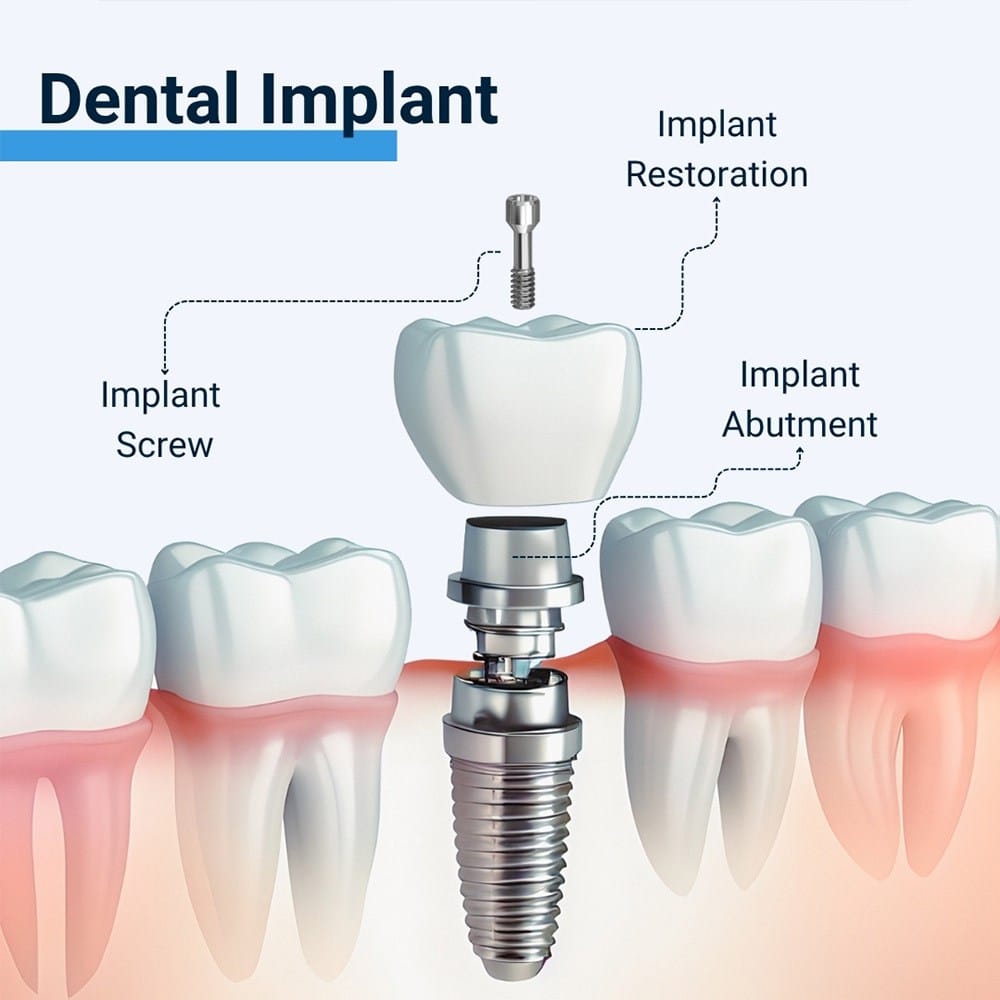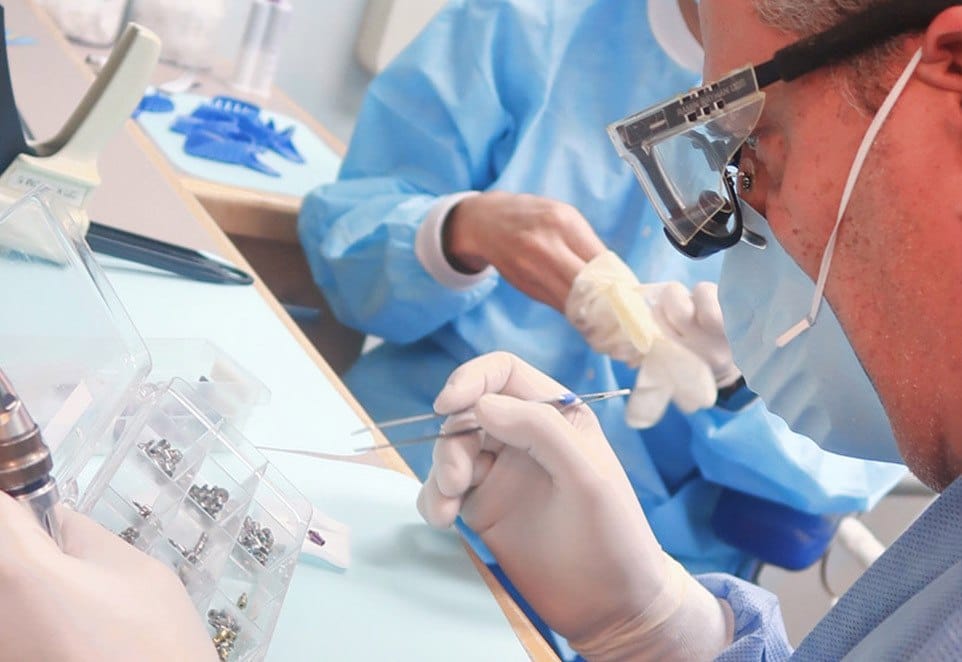This article explains how a dental implant works and the procedure for planning and placing dental implants. We provide a general timeline for treatment, but remember that this will vary because your oral health needs are unique. When you see an implant dentist, they will provide a customized treatment plan for the best outcome.
What Are Dental Implants?
Very briefly, dental implants replace a natural tooth root artificially. They have three separate components, which are the implant post or screw, the abutment or connector, and the implant restoration.

Dental Implant Screw
The implant screw is the part that replicates a natural tooth root and is inserted surgically into the jawbone. Once inserted, it gradually begins to fuse or bond with the bone around it during a process called Osseointegration. Osseointegration can take several months to complete; anywhere from 2 to 6 months may be needed.
Implant Abutment
The implant abutment is attached to the screw, protruding just above the jawline. It is used to connect the implant restoration firmly.
The type of abutment used depends on the type of restoration chosen to replace your missing teeth. There are many types available and in a variety of shapes and sizes.
Implant Restoration
An implant restoration may be an implant crown or a dental implant bridge, both of which are firmly and permanently attached to the implant abutment. Usually, these restorations are screwed into place.
Crowns and Bridges
Implant crowns are ideal for replacing single missing teeth. An implant bridge has two crowns that fit onto implants on either side of the gap, holding one or more replacement teeth, each of which is called a pontic between them. Implant bridges can be used to restore one or more missing teeth originally side-by-side, meaning you don’t need to replace every single missing tooth with an implant.
Implant Dentures
Another alternative is to have an implant-supported denture. Unlike a crown or bridge, an implant denture is removable but has attachments on its fitting surface. These attachments clip onto special abutments on the implants, securing the denture firmly in place.
Whenever you need to remove the denture, you can simply snap it out of the mouth so it is easy to look after and keep clean.
Implant bridges and dentures can restore complete arches of teeth, sometimes using relatively few dental implants, so treatment is highly affordable.
Understanding the Implant Process
The process to insert a dental implant is relatively quick, but you will need several appointments over several months. The general steps required are outlined below.
Implant Consultation
An initial implant consultation is needed to determine if you are suitable for treatment and, if so, how many teeth must be replaced. During this appointment, your implant dentist will examine your mouth and review your medical history in case you have any pre-existing conditions that could affect treatment.
You need reasonable dental and medical health to be a good candidate and should not have any oral health issues like active gum disease. Your dentist will want to discuss your treatment goals to determine which implant solution might suit you best.
At this stage, you can also learn more about sedation dentistry if appropriate. Dental sedation can be adjusted to accommodate your needs. It may be useful for anyone who feels slightly anxious or nervous about treatment or requires multiple implants or a more complex procedure.
Your visit may include diagnostic imaging such as digital dental X-rays and a cone beam CT scan. These diagnostic images allow your implant dentist to assess your jawbone and the condition of any existing teeth. They provide valuable information about any teeth that may need removing and if other procedures are needed, such as bone grafting.
Treatment Planning
Your implant dentist can plan your treatment between your appointments. They use the diagnostic images to plan treatment accurately using computer-guided surgery. The images are manipulated so your implant dentist can ensure that each implant is inserted into bone that is strong, healthy, and able to support it. These images also enable your implant dentist to check the functionality and appearance of the final implant restorations.
It’s extremely important that every implant is inserted optimally and avoids important structures like nerves and blood vessels. The treatment outcome can be affected if implant placement isn’t exactly right. It could mean that your final implant restorations don’t look quite as good as expected or function as well as real teeth.
After your treatment plan is finalized, your dental implant dentist will create a computer-generated surgical stent. A surgical stent is a template used to guide them during surgery, ensuring the plan is replicated precisely. It is a process that ensures your implant treatment is faster, more accurate, and with quicker healing afterward.
Planning and Completing Any Additional Treatments
If you need teeth removed or bone grafting, your dentist must plan these procedures. Sometimes, these treatments can be completed simultaneously as implant placement. For example, bone grafting may be possible if you only require a small amount of grafting material.
Other times, these treatments must be completed beforehand, and your mouth must be left to heal. Your implant dentist can advise you of the best plan during your consultation.
Implant Surgery
Dental implant surgery can take as little as an hour to place a single dental implant. However, if you require multiple implants, then treatment will take longer.
Once you are comfortable in the dental chair, your dentist will provide sedation dentistry if required, and this can be done before your mouth is numbed. When your mouth is numb, the treatment begins using the surgical stent created from your treatment plan.
Dental implant surgery shouldn’t feel painful, although you may feel slight pressure as the implant is inserted and tightened into place. Once the implant is in position, it may be covered and left to heal.
Alternatively, some implant treatments allow for immediate implant restoration. If you are suitable for immediate implants, you can receive a temporary restoration fabricated before your implant surgery and fitted soon afterward.
Immediate dental implants are generally only designed to be temporary and are largely to restore appearance. They are likely unsuitable for biting and chewing harder or crunchy foods.
Recovery and Healing
After your implant surgery, your implant dentist will provide useful information on caring for your mouth during healing. It’s important to keep the surgery site clean. You may be advised to use an antimicrobial mouthwash or given antibiotics to reduce the risk of infection. Try to follow these instructions closely, as they are designed to ensure the healing process is smoother and more comfortable, minimizing the risk of infection.
During healing, you will likely need to follow a soft food diet. Your dental office will provide a list of foods suitable for eating during healing so you can stock up before surgery.
Implant Restoration
You can expect healing to take anywhere from 2 to 6 months. The process should be smooth and uneventful, but if you have any concerns, always contact your dental office for immediate help and advice.
After healing, you will return to your dental office so your implant dentist can fabricate your permanent implant teeth. Your temporary teeth are removed so your implant dentist can take a detailed dental impression. The impression and a detailed prescription are sent to the dental lab for custom fabrication.
These permanent restorations generally take two or more weeks to custom-make. Your final appointment is to have them fitted in place and to discuss how to care for them.
Long-Term Dental Implant Care
Dental implants are a long-term solution for tooth loss, so you should be able to enjoy them for many years or for life. However, be prepared to look after them.
Caring for dental implants isn’t time-consuming or tricky, but you must follow a good daily oral care routine. Your implant dentist or hygienist can discuss this with you and ensure you know how to clean around your implants thoroughly.
Regular dental checkups and hygiene appointments are equally as important. During these visits, your implant dentist can check the condition of your implants. Your hygienist can clean them professionally, ensuring they continue to look good and feel strong and durable.
You Might Only Need as Few as Four Dental Appointments
Dental implant treatment is complex, but you may only need four appointments over several months. These appointments are to plan treatment, complete implant surgery, take a detailed dental impression, and finally, fit your new teeth.
Allow Plenty of Time for Implant Treatment
Many people plan implant surgery to celebrate special life events or the vacation of a lifetime. If this is the case, ideally, plan to complete your treatment well in advance with Clock Tower Dental, so you don’t have to rush your new implant teeth. This will allow plenty of time to complete any additional procedures if needed, like gum or bone grafting or treating existing conditions like active gum disease.

